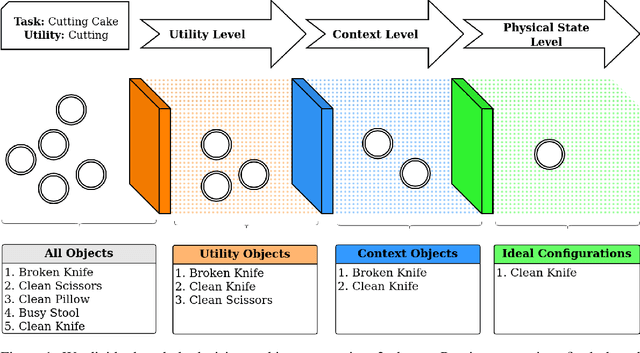Raghav Prabhakar
Physical Reasoning and Object Planning for Household Embodied Agents
Nov 22, 2023



Abstract:In this study, we explore the sophisticated domain of task planning for robust household embodied agents, with a particular emphasis on the intricate task of selecting substitute objects. We introduce the CommonSense Object Affordance Task (COAT), a novel framework designed to analyze reasoning capabilities in commonsense scenarios. This approach is centered on understanding how these agents can effectively identify and utilize alternative objects when executing household tasks, thereby offering insights into the complexities of practical decision-making in real-world environments.Drawing inspiration from human decision-making, we explore how large language models tackle this challenge through three meticulously crafted commonsense question-and-answer datasets, featuring refined rules and human annotations. Our evaluation of state-of-the-art language models on these datasets sheds light on three pivotal considerations: 1) aligning an object's inherent utility with the task at hand, 2) navigating contextual dependencies (societal norms, safety, appropriateness, and efficiency), and 3) accounting for the current physical state of the object. To maintain accessibility, we introduce five abstract variables reflecting an object's physical condition, modulated by human insights to simulate diverse household scenarios. Our contributions include insightful Object-Utility mappings addressing the first consideration and two extensive QA datasets (15k and 130k questions) probing the intricacies of contextual dependencies and object states. The datasets, along with our findings, are accessible at: \url{https://github.com/com-phy-affordance/COAT}. This research not only advances our understanding of physical commonsense reasoning in language models but also paves the way for future improvements in household agent intelligence.
Instance-Level Semantic Maps for Vision Language Navigation
May 23, 2023Abstract:Humans have a natural ability to perform semantic associations with the surrounding objects in the environment. This allows them to create a mental map of the environment which helps them to navigate on-demand when given a linguistic instruction. A natural goal in Vision Language Navigation (VLN) research is to impart autonomous agents with similar capabilities. Recently introduced VL Maps \cite{huang23vlmaps} take a step towards this goal by creating a semantic spatial map representation of the environment without any labelled data. However, their representations are limited for practical applicability as they do not distinguish between different instances of the same object. In this work, we address this limitation by integrating instance-level information into spatial map representation using a community detection algorithm and by utilizing word ontology learned by large language models (LLMs) to perform open-set semantic associations in the mapping representation. The resulting map representation improves the navigation performance by two-fold (233\%) on realistic language commands with instance-specific descriptions compared to VL Maps. We validate the practicality and effectiveness of our approach through extensive qualitative and quantitative experiments.
 Add to Chrome
Add to Chrome Add to Firefox
Add to Firefox Add to Edge
Add to Edge